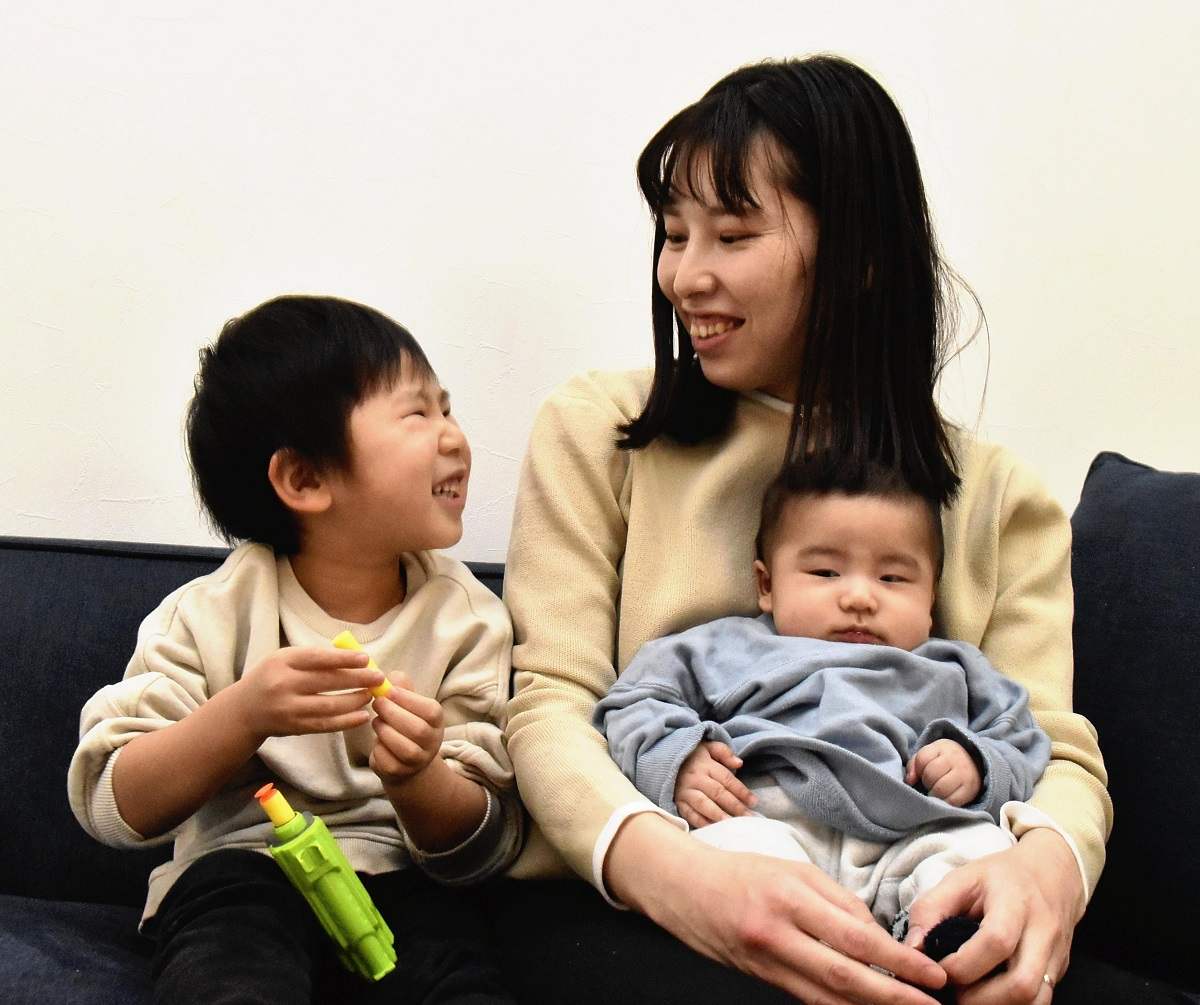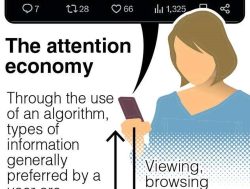
Himeno Sekiguchi talks with Takara, left, while holding Joi on her knees at her home in Shiwa, Iwate Prefecture, on Feb. 10.
By Kanta Kuroyama / Yomiuri Shimbun Staff Writer
19:41 JST, February 25, 2021
This is the fifth and final installment of a series in which Yomiuri Shimbun reporters revisited people affected by the Great East Japan Earthquake in March 2011 and who were interviewed by the newspaper at the time.
MORIOKA — Sorting papers at her home, police officer Himeno Sekiguchi, 31, discovered a letter she received 10 years ago. An officer with the Iwate prefectural police, Sekiguchi was taken back into the past as she looked at the message, which had been sent by Prof. Hirotaro Iwase of the forensic medical lab at Chiba University.
“We were overwhelmed as we saw trucks carrying bodies, and bereaved family members breaking down in tears,” wrote Iwase, 53. “But among the male officers, a tall female police officer with a ponytail kept on working in the dark sports gym where there was no electricity. Seeing her gave us courage.”
Iwase had been conducting autopsies in the gym of the now defunct Yonesaki Junior High School in Rikuzentakata, Iwate Prefecture, which was being used as a makeshift morgue after the disaster. Sekiguchi guided the bereaved family members of victims.
Immediately after the massive earthquake, Sekiguchi ran out of the koban police box beside JR Ofunato Station where she was on duty, and guided residents to evacuation sites. The koban was later washed away by tsunami.
Several days later, she was appointed to guide bereaved family members at the makeshift morgue. She had become a police officer only about a year before, wanting to help people.
The number of bodies brought into the morgue surpassed 300 at its peak, and they were also placed on the stage area in the gym and in classrooms. With not enough coffins available, many bodies were put into bags.
Searching for family members or friends, many people silently looked at the bodies one by one. Sekiguchi opened the bags when people asked to see their faces.
She told herself, “If I let my emotions take over, I won’t make it.” Among the bodies were little children who were barely recognizable. Though Sekiguchi was stunned, she focused completely on her role as a guide.
“It was hard to know what to say to them, as my family members were all safe,” she recalled. To help identify the bodies as soon as possible, Sekiguchi walked around the gym after finishing her work as a guide, creating records describing the belongings and characteristics of the bodies in a readily understandable manner.
A newspaper article showed Sekiguchi interacting with bereaved family members. When Iwase saw it, he knew that the female police officer with a ponytail was Sekiguchi. He wrote to her, and Sekiguchi’s heart was touched. She said she thought, “This person understands my feelings.”
About 1½ months later, she returned to her duty at the koban, patrolling shelters and temporary housing units. She always thought about what she could do.
According to Kanako Ota, 38, an assistant police inspector who was Sekiguchi’s superior at the time: “She was well-liked by residents. They said, ‘We feel relieved when she comes.’”
Sekiguchi was later transferred to a police station in an inland area. She eventually gave birth to two children, and is currently on childcare leave.
She feels happy when her 3-year-old son, Takara, brings her a new diaper for Joi, who was born last October. Sekiguchi said that she now understands the importance of the time when she can be with her family.
She wants to convey how she felt and acted at that time to her sons and junior colleagues. In October this year, Sekiguchi will return to her duties as a police officer.
She doesn’t think it’s a coincidence that the letter she received 10 years ago has been rediscovered now.
An officer’s heartfelt prayer
Sekiguchi was first interviewed by The Yomiuri Shimbun in the makeshift morgue, 18 days after the Great East Japan Earthquake.
At the time, she guided people who came to the morgue from morning to night every day. When people did not find relatives there and departed for another morgue, she bowed toward their backs as they left to express her condolences. In front of the bodies, she quietly said, “I hope they can be found by their family members as soon as possible,” in an article carried on April 2, 2011.
Popular Articles
Popular articles in the past 24 hours
-

Japan's H3 Rocket Failed in Latest Launch, Says Official
-

Hong Kong Police Detain 15 in Robbery Case Involving Theft of ¥1 ...
-

Suntory CEO Says Beer to Be Company's ‘Top Priority;’ Tax Cut on ...
-

Japanese Prime Minister Sanae Takaichi to Move into Official Resi...
-

Japanese Govt to Trial Offering Bidding Preference to Constructio...
-

Imperial Family Views Photo Exhibition Themed on Wartime Tokyo to...
-

Poll Finds High Approval Rating for PM Takaichi’s Economic Measur...
-

A Middle-Class Family's Only Option: A $43,000 Health Insurance P...
Popular articles in the past week
-

Israeli Tourists Refused Accommodation at Hotel in Japan’s Nagano...
-

U.S. Senate Resolution Backs Japan, Condemns China's Pressure
-

Kenta Maeda Joins Rakuten Eagles; Returns from American MLB to Ja...
-

Sharp Decline in Number of Chinese Tourists But Overall Number of...
-

China Attacks Japan at U.N. Security Council Meetings; Representa...
-

Japan Set to Participate in EU's R&D Framework, Aims to Boost Coo...
-

Japan Backs Public-Private Cooperation on Economic Security; Nati...
-

Bus Bound for Hokkaido's New Chitose Airport Catches Fire Wednesd...
Popular articles in the past month
-

Tokyo Economic Security Forum to Hold Inaugural Meeting Amid Tens...
-

Keidanren Chairman Yoshinobu Tsutsui Visits Kashiwazaki-Kariwa Nu...
-

Imports of Rare Earths from China Facing Delays, May Be Caused by...
-

University of Tokyo Professor Discusses Japanese Economic Securit...
-

Japan Pulls out of Vietnam Nuclear Project, Complicating Hanoi's ...
-

Govt Aims to Expand NISA Program Lineup, Abolish Age Restriction
-

Blanket Eel Trade Restrictions Rejected
-

Key Japan Labor Group to Seek Pay Scale Hike
"Society" POPULAR ARTICLE
-

M4.9 Earthquake Hits Tokyo, Neighboring Prefectures
-

Israeli Tourists Refused Accommodation at Hotel in Japan’s Nagano Pref., Prompting Protest by Israeli Embassy and Probe by Prefecture
-

M7.5 Earthquake Hits Northern Japan; Tsunami Waves Observed in Hokkaido, Aomori and Iwate Prefectures
-

Tsukiji Market Urges Tourists to Avoid Visiting in Year-End
-

M5.7 Earthquake Hits Japan’s Kumamoto Pref., Measuring Upper 5 Intensity, No Tsunami Expected
JN ACCESS RANKING
-

Tokyo Economic Security Forum to Hold Inaugural Meeting Amid Tense Global Environment
-

Keidanren Chairman Yoshinobu Tsutsui Visits Kashiwazaki-Kariwa Nuclear Power Plant; Inspects New Emergency Safety System
-

Imports of Rare Earths from China Facing Delays, May Be Caused by Deterioration of Japan-China Relations
-

University of Tokyo Professor Discusses Japanese Economic Security in Interview Ahead of Forum
-

Japan Pulls out of Vietnam Nuclear Project, Complicating Hanoi’s Power Plans






